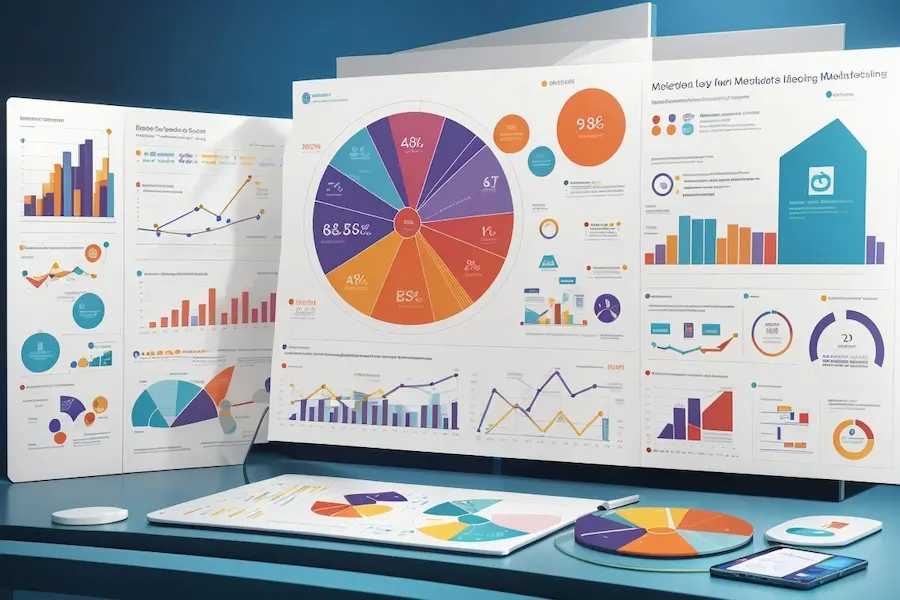1. Introduction to Digital Marketing Metrics and KPIs
Digital marketing has revolutionized the way businesses reach and engage with their audiences. But how do you really know if your strategies are paying off? The answer lies in metrics and KPIs (Key Performance Indicators). Let’s dive deep into understanding what these are and why they matter.
In the realm of digital marketing, metrics are the data points that measure the performance of your campaigns. Meanwhile, KPIs are the specific metrics that align with your business objectives and truly define success. Confused? Let’s break it down further.
2. Website Traffic: The Basic Measure
Your website acts as the hub of all your online marketing efforts. If no one’s visiting, then something’s amiss. Website traffic is a fundamental metric that helps gauge how many people are landing on your site.
Now, not all traffic is created equal. You might have thousands of visitors daily, but if they’re not your target audience or they don’t engage with your content, are they really valuable? That’s where KPIs like bounce rate and session duration come into play.
3. Conversion Rate: From Visitors to Customers
Driving traffic to your site is one thing, but converting that traffic into customers is the real deal. Conversion rate measures the percentage of visitors who take a desired action, be it signing up for a newsletter or making a purchase.
The thing about conversion rate is it gives you a clear picture of your website’s effectiveness. A high traffic site with a low conversion rate could point to issues with site design, user experience, or messaging.
4. Click Through Rate (CTR): Grabbing Attention

In the realm of paid ads and email marketing, CTR is king. It measures how often people click on your ad or email link compared to how many times it’s viewed.
Think of it this way: if you’re running an ad and a thousand people see it but only five click on it, there’s probably something about the ad that’s not resonating. Adjusting your strategy based on CTR can lead to better ad performance and higher ROI.
5. Customer Acquisition Cost (CAC): Spending Smartly
How much does it cost to acquire a new customer? That’s what CAC tells you. It’s crucial because if you’re spending more on acquiring customers than what they’re bringing in, you’re running at a loss.
Digital marketing offers a unique advantage here – the ability to precisely track and adjust your CAC, helping you optimize spend and improve profitability.
6. Customer Lifetime Value (CLV): Beyond the First Sale
While acquiring new customers is vital, understanding their value over time is even more critical. CLV tells you how much revenue you can expect from a customer over the duration of your relationship.
When you compare CLV to CAC, you gain insights into the sustainability of your business model. A high CLV compared to a low CAC? You’re on the right track!
7. Social Media Engagement: More than Just Likes
Social media isn’t just about gathering followers. It’s about engagement. Metrics like comments, shares, and even the sentiment of feedback can offer valuable insights.
The key is to go beyond vanity metrics. 10,000 followers don’t mean much if they’re not interacting with your content or acting upon your calls-to-action.
8. Email Open and Response Rates: Hitting the Inbox Right

Sending emails is easy. Getting them read? That’s the challenge. Email open rates tell you how often your emails are being opened, while response rates dive deeper into actions taken post-opening.
A well-optimized email marketing strategy can achieve remarkable ROI, but it’s essential to keep an eye on these KPIs to ensure you’re hitting the mark.
9. Retention and Churn Rates: Holding onto Customers
Lastly, in the fast-paced world of digital marketing, retaining customers can often be overlooked. However, it’s just as important as acquiring them. Retention rates measure how many customers stick around, while churn rates tell you how many decide to leave.
By understanding and optimizing these metrics, you can foster lasting relationships with your customers and ensure steady growth for your business.
Explore the rest of our website Tech Glints, intriguing articles await you! Interested in contributing? Simply click the contact button at the top right. Thank you!
